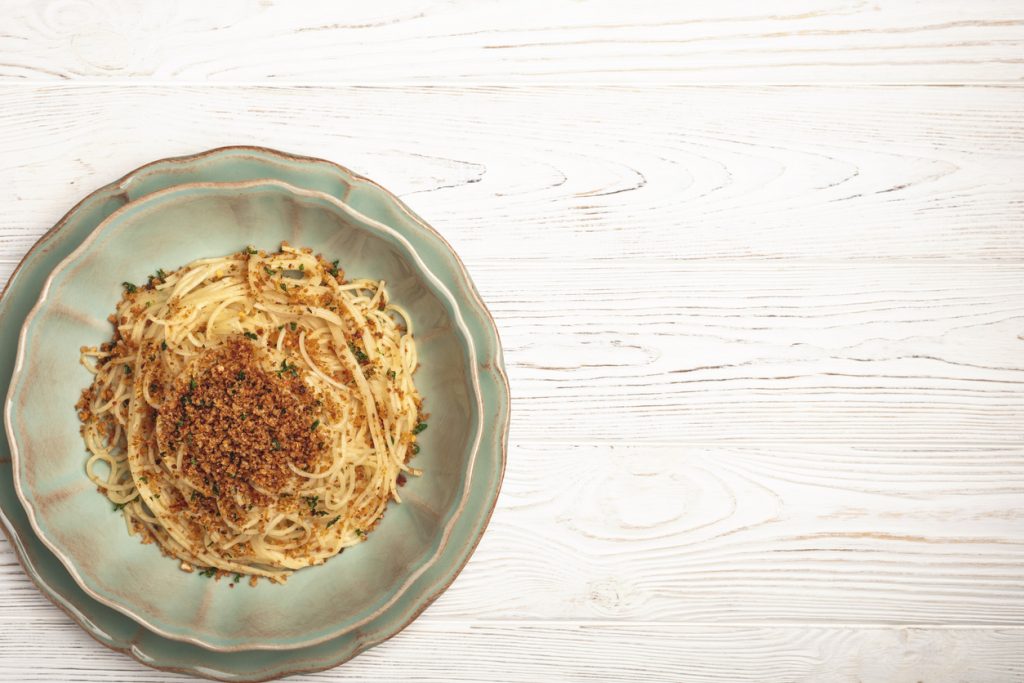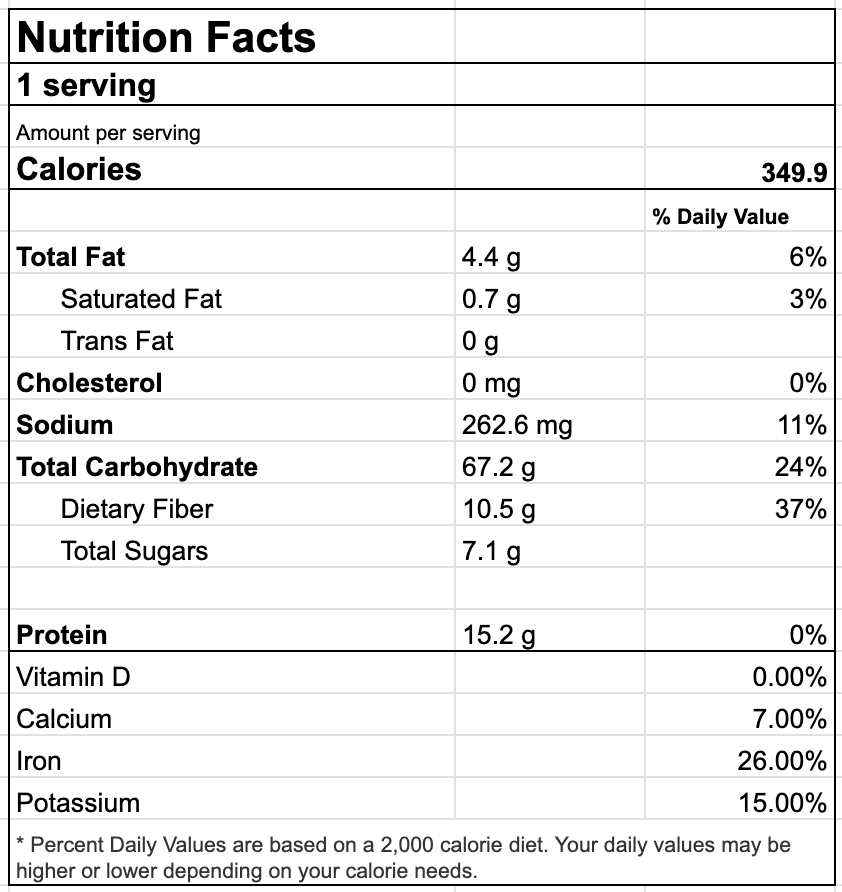By Charlotte Bresee, Dietetic Intern

Spaghetti and meat sauce is a classic meal that so many families enjoy. Try this easy meatless pasta sauce for a vegetarian option. Swapping one of your red meat meals for a legume-based meal is a great way to reduce your risk of chronic disease. We suggest using a whole wheat pasta for additional fiber and nutrients. The lentils give the sauce a texture similar to a meat sauce and provide you with important nutrients. And the best part about this recipe is that it can be meal prepped for easy meals throughout the week. No more last-minute lunch purchases when you have nutritious food ready to go!
Ingredient Highlights:
Lentils: Lentils are a nutritious, fiber-rich legume. Lentils are nutritious due to their high plant-based protein, fiber, iron, and mineral content [i]. Lentils are also low in saturated fat, cholesterol and sodium [i]. Consuming ½ cup of beans or lentils on a daily basis is associated with a reduced risk of chronic diseases such as diabetes, heart disease and cancer [i]. The lentils in this recipe add a delicious savory flavor.
Peppers: Bell peppers are high in vitamin C, vitamin A, and fiber [ii]. A medium bell pepper contains over 100% of your daily serving of vitamin C [ii]. Vitamin C is an antioxidant that helps reduce damage caused by free radicals. Pairing vitamin C-rich peppers in this recipe is particularly important for promoting the absorption of the non-heme iron found in lentils. Vitamin C is also important for the production of collagen which is a type of protein found in our skin [iii].This means that eating peppers and other vitamin C-rich foods can support your skin health.
Tomatoes: Tomatoes are another important component in this recipe because they create the delicious sauce. In this recipe we use both canned tomatoes and tomato paste for a rich sauce. Tomatoes are high in a phytonutrient called lycopene [iv]. Lycopene is a carotenoid which is a type of antioxidant. Lycopene is highly potent which means that consuming tomatoes is an important way to reduce free radical damage and protect against cancer [iv].
Garlic: Garlic is a small but mighty ingredient for both flavor and health purposes. Garlic has powerful antioxidant and anti-inflammatory properties [v]. Components in garlics such as flavonoids, tannins, and sulfur compounds are thought to play important roles in the health benefits. For example, garlic has been show to help lower blood sugar levels for diabetic patients and improve lipid profiles [v]. Learn more about the many health benefits of garlic and tips on how to enjoy it. This recipe includes 3 cloves of garlic which add a wonderful aroma and support the immune system.
Onions: Onions provide similar benefits to garlic because they are both part of the Allium group which have antioxidant and anti-inflammatory properties [vi]. Onions are low in calories while adding important flavor to dishes. There is evidence that consumption of vegetables in the Allium family, like onions, are associated with reduced risk of several types of cancer [vi]. Overall, including onions in recipes like this tasty spaghetti recipe is a great way to enjoy the nutrition benefits.
Recipe makes 4 servings, 1 cup each:
Ingredients
- ½ cup dry green lentils (rinsed) – 100 grams
- 1 ½ cups of water
- 1 pinch of salt
- 1 tbsp olive oil
- 3 cloves of garlic, minced – 10 grams
- 1 small onion, diced – about 120 grams
- 1 large red or green pepper, diced – 200 grams
- 1 15-ounce can diced tomato (or tomato sauce)
- 2 tbsp tomato paste
- ¼ tsp red pepper flakes (optional)
- 1 ½ tbsp dried oregano
- 1 tbsp dried basil
- 1/8 tsp salt
- 8 oz whole wheat spaghetti
- Optional toppings: shredded mozzarella or parmesan cheese
Instructions
- In a small saucepan, combine lentils, water and a pinch of salt. Bring to a boil over medium heat. Once boiling, cover and reduce heat to a simmer. Cook until tender, about 15-20 minutes.
- Drain excess liquid from the lentils and set them aside.
- While lentils are cooking, heat oil in a cast iron skillet pot over medium heat. Once hot, add onions and peppers. Sauté for 3 minutes, stirring frequently.
- Add garlic and sauté for 1 minute.
- Add canned tomato, tomato paste, oregano, basil, and salt. If you are adding red pepper flakes, add those in now too. Stir to combine.
- Reduce heat and bring to a low simmer. Cover and cook for about 20 minutes, stirring occasionally.
- Meanwhile, cook pasta according to package instructions at this time. Reserve ½ cup of pasta water at the end of the pasta cooking time. Then drain the pasta and set aside.
- Sample pasta sauce and adjust seasonings as needed. Add ¼ cup of pasta water to thin the sauce, using more if necessary.
- Add the cooked, drained lentils to the tomato sauce and stir to combine.
- Serve the sauce over the pasta. Top with fresh basil and a pinch of mozzarella or parmesan.
If you are in need of a quicker version of this recipe, skip the homemade tomato and pepper sauce. Instead, prepare ½ cup of lentils as directed and set aside. Follow the package instructions for your favorite whole wheat pasta. Combine 2 cups of jarred marinara sauce with the cooked lentils in a saucepan. Served over the cooked pasta.
Additional Customizations:
- Vegan: Omit the cheese topping to keep this recipe completely vegan.
- Gluten-Free: Substitute gluten-free pasta instead of whole wheat pasta to make this a gluten-free dish.
- Lower Carbohydrate: Reduce the pasta amount by half and add spiralized zucchini for a lower carbohydrate noodle.
- Quick Lentils: You can also use 1 cup of precooked lentils instead of cooking the dried lentils.

References:
[i] Ganesan K, Xu B. Polyphenol-Rich Lentils and Their Health Promoting Effects. Int J Mol Sci. 2017 Nov 10;18(11):2390. doi: 10.3390/ijms18112390. PMID: 29125587; PMCID: PMC5713359. [ii] “FoodData Central.” Fdc.nal.usda.gov, US Department of Agriculture, 28 Apr. 2022, fdc.nal.usda.gov/fdc-app.html#/food-details/2258590/nutrients. Accessed 23 May 2023. [iii] Pullar JM, Carr AC, Vissers MCM. The Roles of Vitamin C in Skin Health. Nutrients. 2017;9(8):866. Published 2017 Aug 12. doi:10.3390/nu9080866 [iv] Agarwal S, Rao AV. Tomato lycopene and its role in human health and chronic diseases. CMAJ. 2000;163(6):739-744. [v] Ansary J, Forbes-Hernández TY, Gil E, et al. Potential Health Benefit of Garlic Based on Human Intervention Studies: A Brief Overview. Antioxidants (Basel). 2020;9(7):619. Published 2020 Jul 15. doi:10.3390/antiox9070619 [vi] Nicastro HL, Ross SA, Milner JA. Garlic and onions: their cancer prevention properties. Cancer Prev Res (Phila). 2015;8(3):181-189. doi:10.1158/1940-6207.CAPR-14-0172